The Trek Slash is a perennial favourite in the enduro market. It was released in 2016 but it still looks up to date today. We were very excited to find out if the bike with its top-end spec could still keep up with the competition.
For an overview of the test fleet head to the group test: The best enduro bike 2020
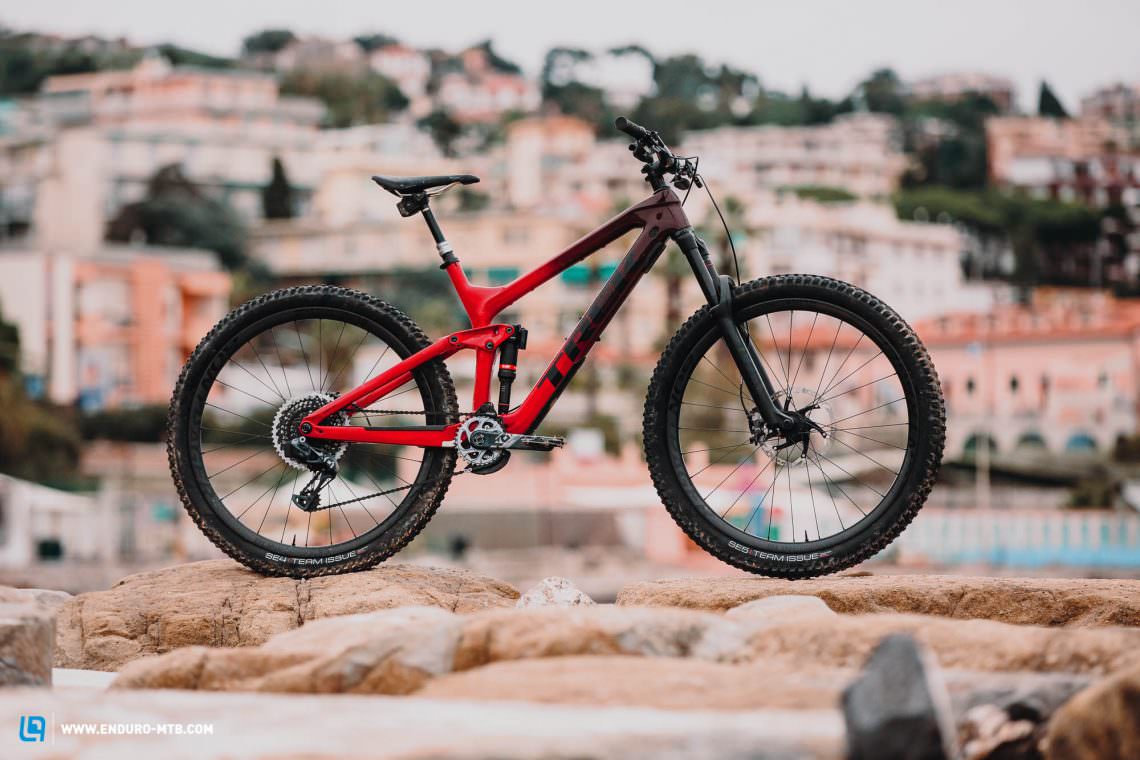
The Trek Slash was one of the first purpose-built enduro bikes with 29″ wheels and it’s got a lot of fans. The frame has remained unchanged since it was first launched in 2016 but last year Trek updated the rear shock with their Thru-Shaft technology, developed in cooperation with Penske Racing. Trek have paired this with a RockShox Lyrik Ultimate fork on their € 8,999 flagship model. Braking is taken care of by a set of powerful Shimano XT four-piston brakes. You also get a wireless SRAM X01 Eagle AXS drivetrain and RockShox Reverb AXS dropper post for minimal cable clutter, keeping the bike looking even cleaner than before – both components perform flawlessly by the way. Weighing in at 13,58 kg, the Slash is the second lightest bike in the test field, thanks in part to the light Bontrager Line Carbon 30 wheelset and the thin-walled Bontrager SE5 Team Issue tires. Trek also rely on in-house Bontrager components for the cockpit, speccing the bike with a 50 mm stem and 800 mm wide handlebar. The Slash is now also included in Trek’s Project One customisation programme, allowing you to modify the paint job however you want, or select one of the preconfigured custom designs – our favourite design is the fiery red ICON Molten Marble.

The workmanship and design of the frame are still excellent with its clean lines and beautifully faded paint job.
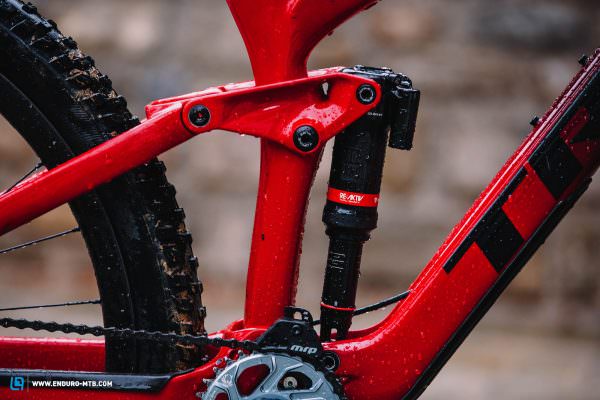
The Thru-Shaft technology on the shock allows the shock piston to pass through the shock as it compresses. By doing so, the oil doesn’t get pressurised and there is no need for an IFP. This is claimed to improve sensitivity and so offer better traction despite the bike’s firm setup.

The Knock Block prevents the fork crown from hitting the down tube. It also makes the bike a lot more difficult to pack into the back of your car or van. We see it as more of a bug than a feature.
Trek Slash 9.9 X01 AXS
€ 8,999
Specifications
Fork RockShox Lyrik Ultimate 160 mm
Rear Shock RockShox Deluxe RT3 Thru Shaft 150 mm
Seatpost RockShox Reverb AXS 170 mm
Brakes Shimano XT 4-Kolben 200/180 mm
Drivetrain SRAM XX1 Eagle AXS 32 - 10/50
Stem Bontrager Line Pro 50 mm
Handlebar Bontrager Line Pro OCLV Carbon 800 mm
Wheelset Bontrager Line Carbon 30 29
Technical Data
Size S, M, L, XL
Weight 13.58 kg
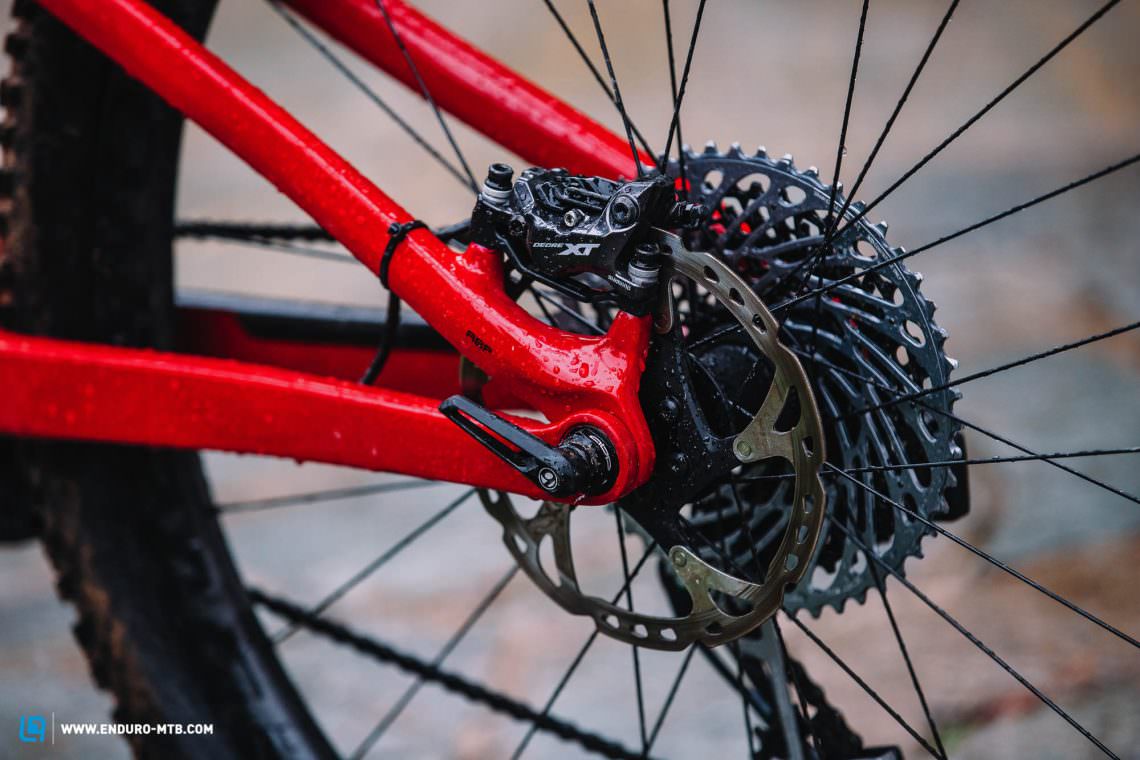
The Shimano XT four-piston brakes perform reliably and offer a lot of braking power. However, you have to bleed them very carefully, or the bite-point will be inconsistent.
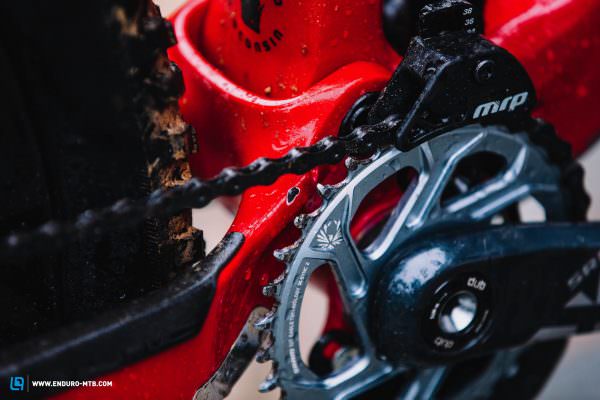
The paint chips on the chainstay are unacceptable at this price point and we would have expected a more effective chainstay protector here. The internally routed cables also rattle in the frame.

The Mino Link flip chip allows you to adjust the geometry. We put it in the low position for the descents and left it there for the remainder of the test.
Geometry and size of the Trek
On paper, the geometry figures of the Slash look outdated. The reach is short and the seat tube angle is too slack. Due to the long seat tube, upsizing isn’t an option for most riders. The geometry can be adjusted via a flip chip, but we recommend you keep it in the slack setting.
| Size | S | M | L | XL |
|---|---|---|---|---|
| Seat tube | 394 mm | 419 mm | 470 mm | 521 mm |
| Top tube | 589 mm | 604 mm | 635 mm | 661 mm |
| Head tube | 100 mm | 100 mm | 110 mm | 125 mm |
| Head angle | 65.6° | 65.6° | 65.6° | 65.6° |
| Seat angle | 64.8° | 64.8° | 64.8° | 64.8° |
| Chainstays | 433 mm | 433 mm | 433 mm | 433 mm |
| BB Drop | 21 mm | 21 mm | 21 mm | 21 mm |
| Wheelbase | 1,171 mm | 1,186 mm | 1,219 mm | 1,247 mm |
| Reach | 416 mm | 431 mm | 459 mm | 481 mm |
| Stack | 608 mm | 608 mm | 618 mm | 631 mm |

The Trek Slash 9.9 X01 AXS on the trail
In times of ever longer bikes, the Slash almost seems old-school with it’s 453 mm reach. However, the moment you ride it you’ll notice how well balanced it feels. Your weight is evenly distributed between the wheels despite the short reach. The bike steers very directly and precisely, immediately responding to any input from the rider. On tight trails, the Slash is easy to manoeuvre and navigate around obstacles and turns. However, as soon as things start getting faster and rougher, it takes a lot of effort to keep the bike on course.
With its firm and direct setup, the Slash rewards an active riding style, which in turn becomes very taxing on the rider in rough terrain.
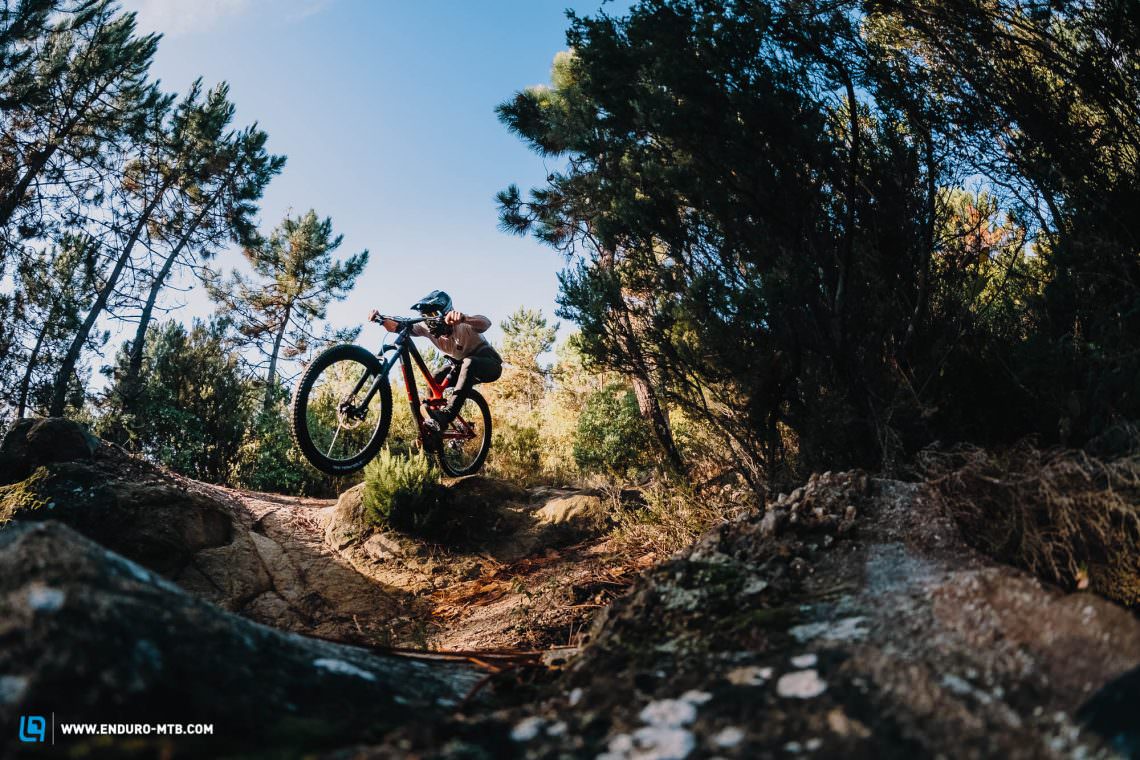
The suspension isn’t very sensitive and generally quite firm. This means that if you have an active riding style and pump the bike, you’ll be able to generate a lot of speed. However, if you’re a less fit rider, it will quickly wear you out. Out of the gate and coming out of corners, the Slash accelerates quickly. The bike isn’t phased by steep terrain, but as short as it is, you’ll have to stay composed and position your centre of gravity carefully. Despite its low weight, the Slash doesn’t climb as well as you’d think since the slack seat tube angle puts you in an awkward pedalling position. Even with the saddle pushed forward, your weight stays too far over the rear wheel and you have to lean your upper body forward to counteract this.
It’s obvious the Slash is a bit long in the tooth – the geometry, suspension and frame details are all outdated.
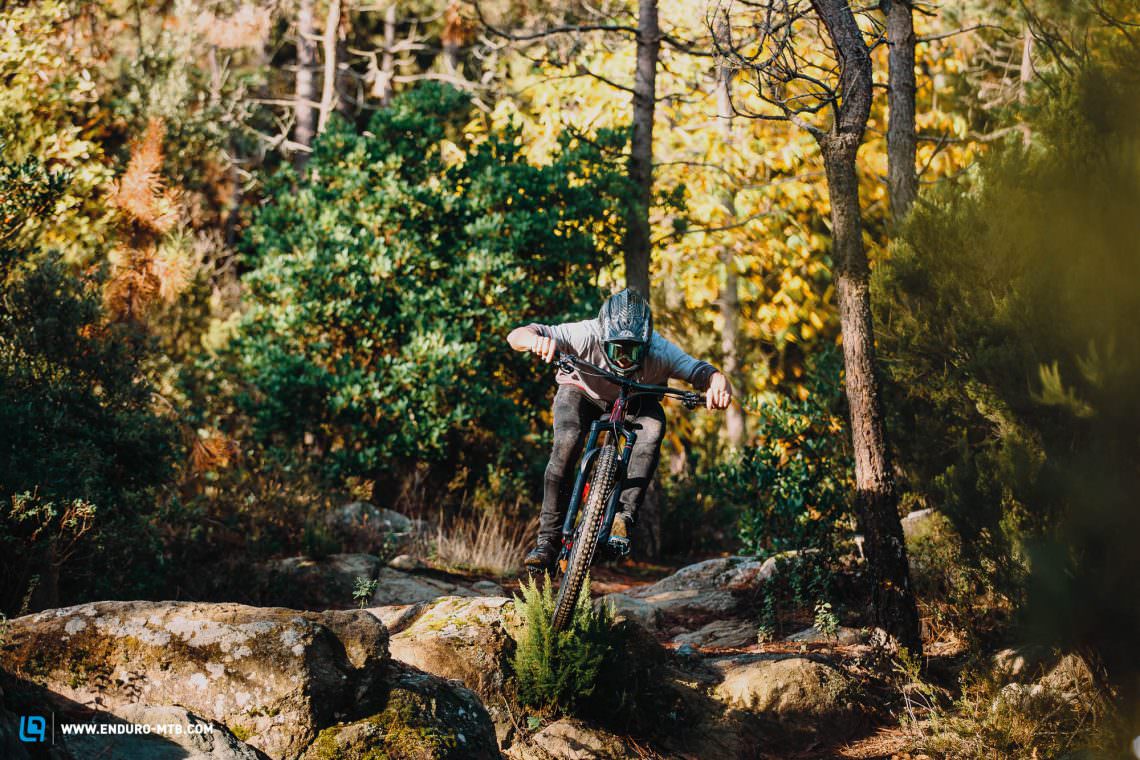
How does the Trek Slash compare to the competition?
For a long time, the Trek Slash was synonymous with 29″ enduro bikes. However, the competition has caught up when tackling rough terrain or technical climbs where the Slash has started falling behind. The biggest strength of the Slash is its precision and direct handling, which only the Orbea Rallon comes close to matching.

Tuning tip: push the saddle all the way forward | fit more robust tires
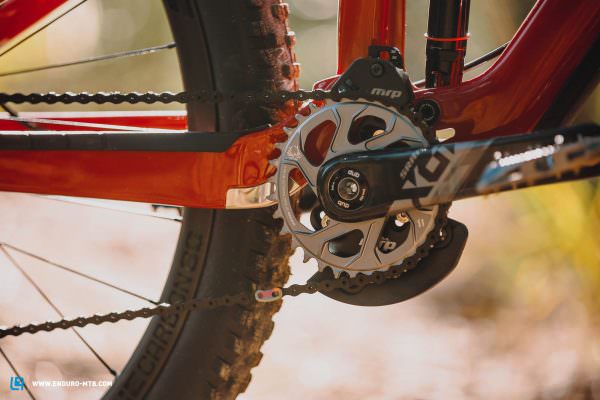

Conclusion
The Trek Slash is by no means a bad bike, but it can no longer keep up with the competition. The handling is very agile and direct, but the compact geometry and the firmly tuned suspension lack stability and composure. As it is, the handling demands a fit and strong rider to get the most from the bike on fast descents.
Tops
- direct, spritely handling
- still looks the part
- easy to ride actively
Flops
- demanding on the rider
- uncomfortable on the climbs
- the frame details can not justify the price
You can find out more about the Trek Slash 9.9 X01 AXS at trekbikes.com
The test field
For an overview of the test fleet head to the group test: The best enduro bike 2020
All bikes in test: Canyon Strive CFR 9.0 LTD | CUBE Stereo 170 SL 29 | Giant Reign Advanced 29 0 | Ibis Mojo HD5 | Norco Sight C1 29 | Nukeproof Mega 275C RS | Nukeproof Mega 290C Pro | Orbea Rallon M-LTD | Pole Stamina 180 LE | RAAW Madonna V2 FOX Factory Built | Rocky Mountain Slayer Carbon 90 29 | Santa Cruz Megatower CC X01 Reserve | SCOTT Ransom 900 Tuned | Specialized S-Works Enduro 2020 | Specialized Turbo Kenevo Expert | Trek Slash 9.9 X01 AXS | Yeti SB150 T2 | YT CAPRA 29 CF Pro Race
Did you enjoy this article? If so, we would be stoked if you decide to support us with a monthly contribution. By becoming a supporter of ENDURO, you will help secure a sustainable future for high-quality mountain bike journalism. Click here to learn more.
Words: Photos: Christoph Bayer / Finlay Anderson / Markus Frühmann









